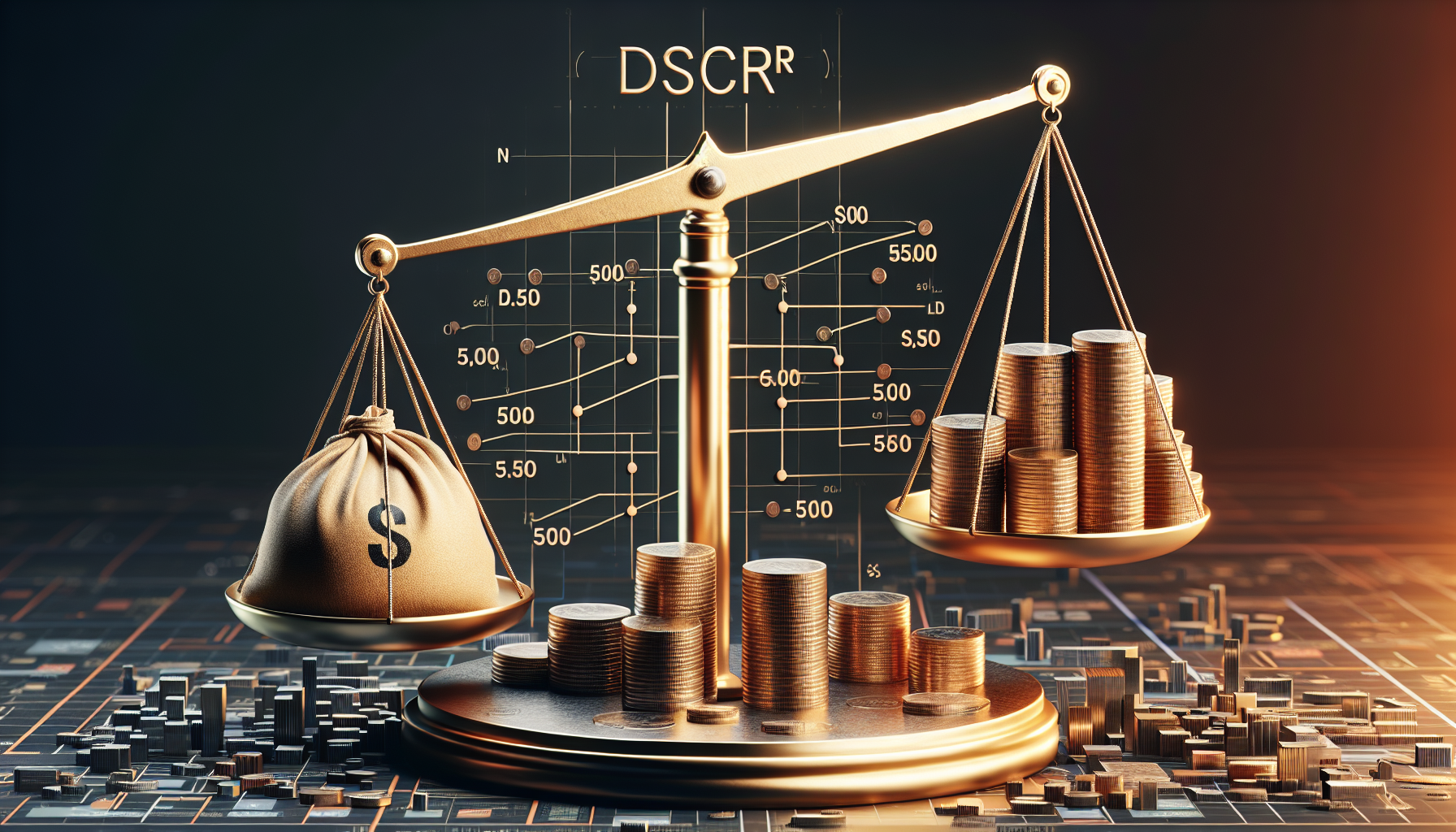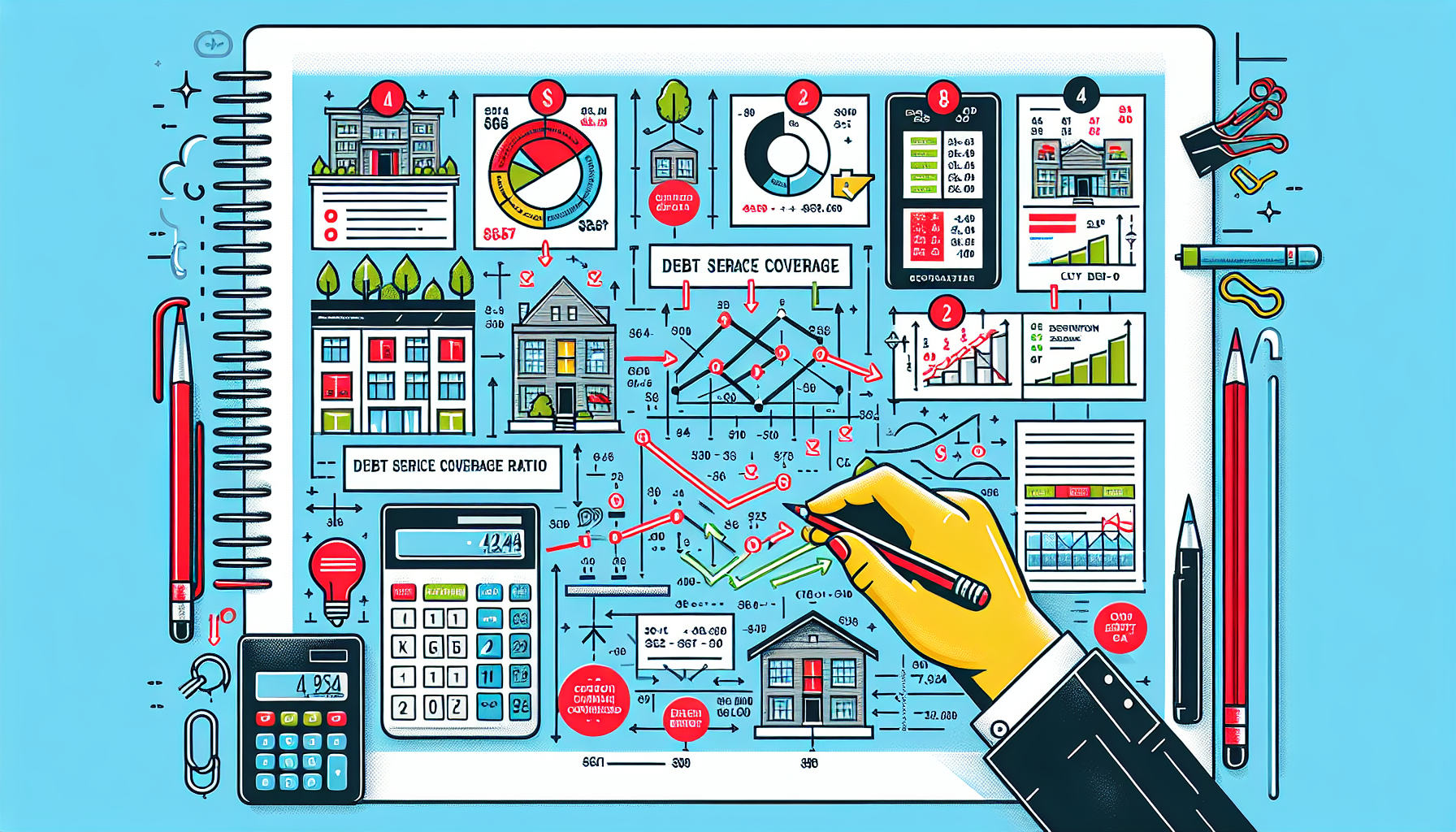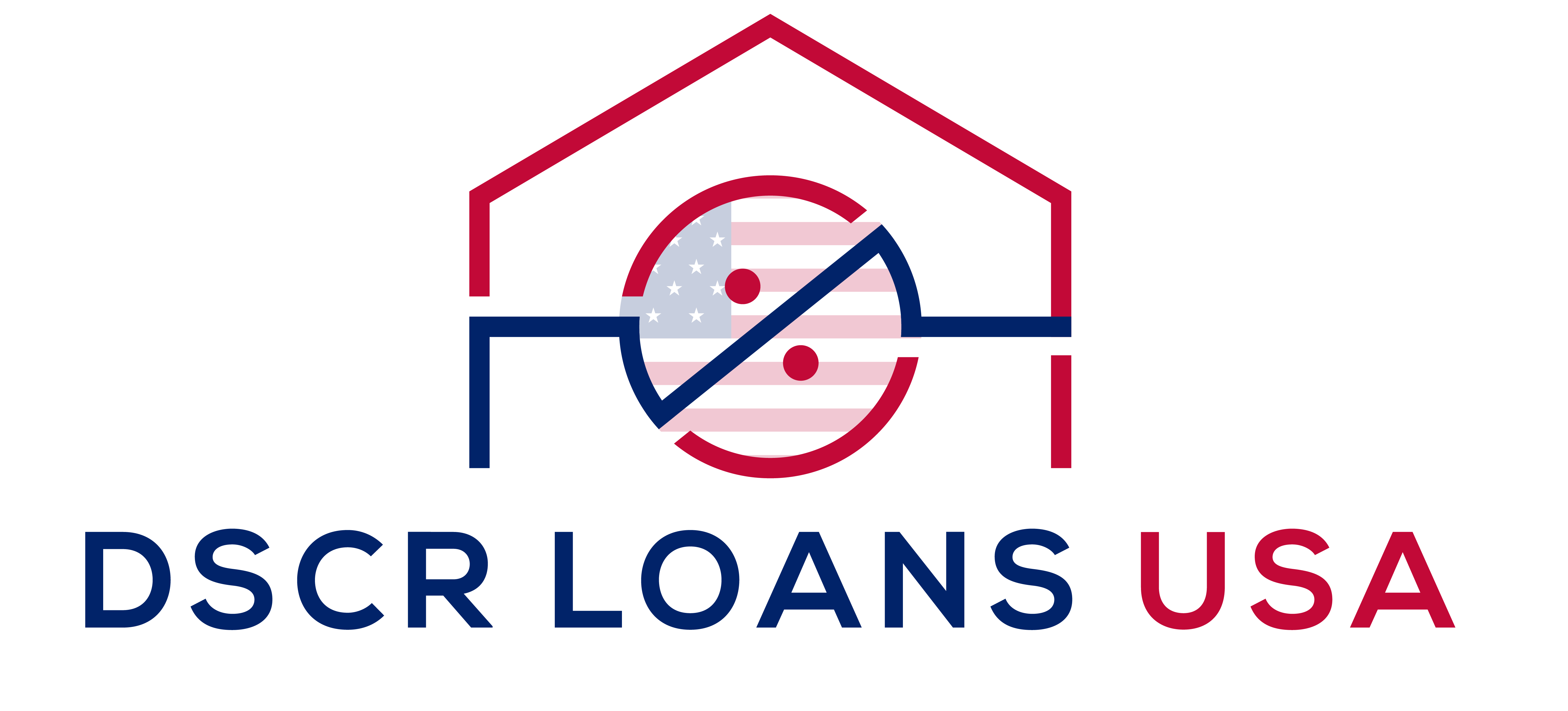Master Your Finances: Debt Service Coverage Ratio DSCR: A Calculation Guide
Need to nail down the Debt Service Coverage Ratio (DSCR)?
This calculation guide isn’t just another explainer – here, you’ll find the straight goods on computing this pivotal financial metric. With our guide, you’ll confidently compare cash flow to debt obligations, key for savvy real estate decisions and satisfying lenders’ criteria. Expect clear, actionable steps ahead – no fluff, just the facts.
Key Takeaways
- The Debt Service Coverage Ratio (DSCR) is a critical metric used in real estate investing to compare a property’s cash flow against its debt obligations, informing lenders and investors of the financial health and risk level of a property.
- Calculating DSCR involves dividing the Net Operating Income (NOI) by the Total Debt Service; a high ratio indicates a property’s robust capability to handle debt, while a DSCR of 1.2 to 1.25 is typically the minimum requirement set by lenders.
- Investors can improve the attractiveness of a property to lenders by increasing DSCR through strategies like enhancing rental income, reducing operating expenses, or refinancing debt to secure better loan terms.
Introduction to DSCR in Real Estate Investing

DSCR measures the cash flow available to pay current debt obligations, essentially comparing a business’s cash flow versus its financial commitments. To calculate dscr, one must analyze the relationship between a company’s cash flow and its debt obligations. This indicates how well a company can meet its financial obligations. It’s used by lenders to evaluate the risk associated with lending to a particular property, making it a vital metric in commercial real estate finance.
Think of DSCR, also known as the coverage ratio, as a signal to lenders. A high DSCR indicates that a property generates enough cash to comfortably cover debt payments, thereby lowering the risk of loan default. But how is this crucial ratio calculated? Let’s break down the DSCR formula to understand its components better.
Breaking Down the DSCR Formula

The Debt Service Coverage Ratio (DSCR) formula is straightforward, involving dividing net operating income by total debt service to calculate the service coverage ratio:
- Net Operating Income (NOI) divided by Total Debt Service
- NOI represents a property’s total income after operating expenses
- Total Debt Service covers all debt obligations, including principal and interest payments.
Both components play a significant role in real estate investments. A high NOI indicates robust property income, while a low Total Debt Service signifies manageable debt levels. Therefore, a high DSCR resulting from a high NOI and a low Total Debt Service is a positive sign for investors and lenders alike.
Calculating Net Operating Income (NOI)

Calculating NOI is like taking your property’s financial pulse. In real estate, NOI is derived by subtracting operating expenses from property income. These expenses can include:
- Property taxes
- Insurance
- Maintenance costs
- Management fees
Accuracy in calculating NOI is critical to determining DSCR, as even small mistakes can significantly skew your results. For instance, including capital expenditures or income taxes in operating expenses is a common error. By correctly accounting for income and expenses, you can ensure your NOI provides an accurate picture of your property’s financial health.
Understanding Total Debt Service in Real Estate
Total Debt Service, the second component of the Debt Service Coverage Ratio (DSCR) formula, encompasses all principal and interest payments associated with a property’s debt, including the company’s debt payments. This includes mortgage loans, bank loans, and other types of financing.
The type of financing can greatly affect the total debt service calculation. For instance, a mortgage with a lower interest rate will result in lower Total Debt Service than a high-interest bank loan. Understanding Total Debt Service and how it’s affected by various financing options is crucial in managing debt and improving DSCR.
Step-by-Step Guide to Calculating DSCR for Real Estate Investments

Calculating DSCR may seem complex, but with a clear understanding of its components, the process becomes straightforward. Start by determining the Net Operating Income (NOI) of your property. This is done by subtracting direct operating expenses like management fees, maintenance costs, property taxes, and insurance from the total income generated from the property.
Next, calculate the annual debt service, which includes the total obligations for financing, primarily composed of principal repayments on mortgage loans and periodic interest payments. Once you have these figures, divide the NOI by the annual debt service, and convert the result to percentage form by multiplying by 100. This result is your DSCR, a crucial metric that commercial lenders view favorably when it indicates a lower risk of default due to a more substantial income margin over the annual debt service.
DSCR Benchmarks in Real Estate
Just as athletes strive to meet or exceed certain benchmarks, real estate investors aim to achieve specific DSCR benchmarks to attract lenders and secure financing. In the real estate industry, a DSCR of at least 2 is considered very strong, indicating that a company can cover twice its debt service obligations with its operating income.
However, lenders often set the minimum DSCR requirements for real estate loans to be between 1.2 and 1.25. This benchmark can vary depending on the stability and risk associated with the property. Therefore, understanding these benchmarks and striving to meet or exceed them can greatly enhance your chances of securing financing.
Using DSCR for Investment Decisions in Real Estate
DSCR is not just a measure for lenders; it’s also a valuable tool for investors. It aids in evaluating property investments, informing decisions on whether to buy, hold, or sell a property.
Imagine you’re considering investing in a commercial property. A high DSCR could indicate that the property’s income is sufficient to cover debt payments, suggesting a good investment. On the other hand, a low DSCR might signal potential financial difficulties, causing you to reconsider the investment or negotiate for better terms.
Thus, understanding DSCR can give you an edge in making informed investment decisions.
Global DSCR Considerations
While DSCR focuses on a specific property’s income and debt service, Global DSCR broadens the perspective to include the property owner’s personal income and expenses, as well as the income and expenses from their related business entities. This broader perspective allows lenders to assess if a borrower has other sources of income that can support the project’s net operating income in case of financial distress.
Therefore, a strong global DSCR can enable borrowers to access larger loans than they might otherwise qualify for based on the DSCR of the property alone. This is particularly important in the underwriting of small business commercial property loans, including SBA 504 or SBA 7(a) loans.
Strategies for Improving DSCR in Real Estate
Improving DSCR is a common goal for real estate investors looking to attract lenders and secure financing. One of the most effective ways to increase DSCR is to boost NOI. This could be achieved through property improvements that raise rental income or better management practices that reduce operating expenses.
Another strategy involves managing debt to improve DSCR. This could involve refinancing to secure more favorable loan terms, reducing the Total Debt Service and thereby increasing the DSCR. By understanding and applying these strategies, investors can enhance their DSCR, making their properties more attractive to lenders.
Navigating DSCR Requirements in Commercial Lending
When approaching lenders for financing, understanding how they view DSCR can be a game-changer. Lenders consider DSCR during the loan approval process for real estate, as it provides insight into the risk associated with lending to a particular property.
Meeting lender DSCR requirements and negotiating loan terms based on DSCR can be a strategic move for borrowers. For instance, a high DSCR could be leveraged to negotiate for lower interest rates or higher loan amounts. Understanding these nuances can help you navigate the commercial lending landscape more confidently and efficiently.
Conclusion: The Role of DSCR in Strategic Real Estate Management
In the realm of real estate investing and financial management, DSCR plays a critical role. It serves as a key financial metric that influences lending decisions, informs investment strategies, and shapes debt management practices.
As we navigate varying economic climates, the importance of maintaining a healthy DSCR remains paramount. Whether you’re an investor evaluating potential property investments or a borrower negotiating loan terms, mastering DSCR calculation and understanding its implications can be a powerful tool in your real estate finance toolkit.
Summary
Throughout this exploration of DSCR, we’ve discovered its vital role in real estate investing and financial management. From its calculation involving NOI and Total Debt Service to its use by lenders and investors, DSCR stands as a decisive metric in commercial real estate. Understanding how to calculate DSCR and interpret its value can open doors to financing opportunities and inform strategic investment decisions.
In the ever-changing world of real estate finance, maintaining a healthy DSCR remains a constant need. Whether you’re just starting your investment journey or are a seasoned investor, mastering DSCR can provide a strong compass guiding you towards profitable ventures. Keep delving deeper, keep learning, and let the numbers lead your way to real estate success. Take your time and find the best DSCR lender before moving ahead.
Frequently Asked Questions
How to calculate dsr ratio?
To calculate the debt service coverage ratio (DSCR), you need to divide the net operating income by the total debt service. For example, if the net operating income is $5000 and the total debt service is $2750, the DSCR is 1.82. This ratio helps assess an entity’s ability to cover its debt service obligations.
How to get a DSCR loan?
To qualify for a DSCR loan, you need a DSCR ratio of 1.0 and above, credit scores of at least 620, a 20% down payment, and a minimum loan amount of $100,000 and a maximum of $3 million.
What does a DSCR of 1.25 mean?
A DSCR of 1.25 means your net operating income is 125% of your debt obligations, indicating that you can pay all your debts with additional cash left over. This ratio is important for lenders when qualifying for a loan.
What is DSCR in real estate investing?
DSCR, or Debt Service Coverage Ratio, measures a property’s cash flow ability to cover debt payments and is used by lenders in real estate investing.
How can I improve my DSCR?
To improve your DSCR, consider increasing your net operating income (NOI) through property enhancements or better management, and managing debt by exploring refinancing opportunities. Refinancing options and property improvements are the key strategies for improving your DSCR.
What does the DSCR loan application process entail?
This is such a popular question that we created a separate post covering “how to get a DSCR loan“, check it out.
Ready for More Great Tips and Information? Join Our Email List Today!

